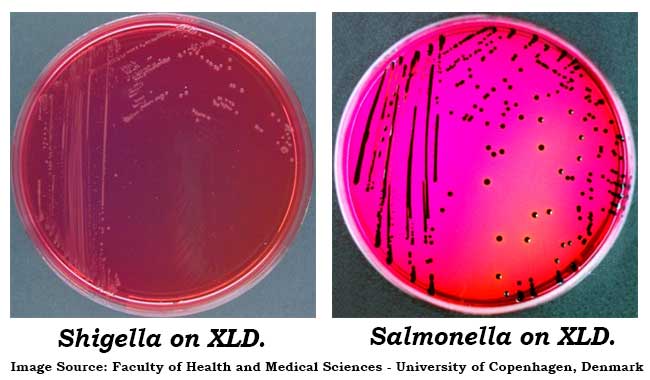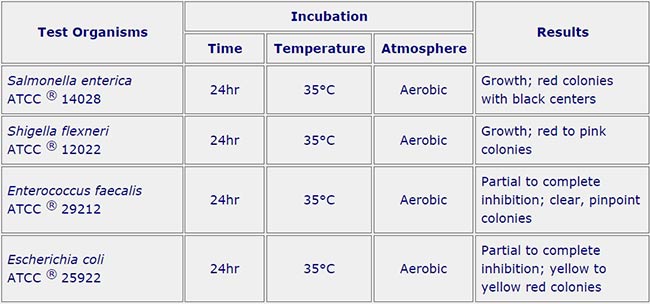Xylose Lysine Deoxycholate (XLD) Agar is a selective medium for the isolation of Salmonella and Shigella spp from clinical specimens and food samples. XLD Agar was originally formulated by Taylor for the isolation and identification of Shigella from stool specimens.
The pathogens are differentiated not only from the non-pathogenic lactose fermenters but also from many non-pathogens which do not ferment lactose or sucrose.
Additionally, the medium was formulated to increase the frequency of growth of the more fastidious pathogens, which in other formulations have often failed to grow due to the inclusion of excessively toxic inhibitors.
The results obtained in a number of clinical evaluations have supported the claim for the relatively high efficiency of XLD Agar in the primary isolation of Shigella and Salmonella. XLD Agar is included in the USP microbial limit test for screening specimens for the presence or absence of Salmonella and is recommended for the testing of foods, dairy products and water.
Principle of XLD Agar
XLD Agar is both a selective and differential medium. It contains yeast extract as a source of nutrients and vitamins. It utilizes sodium deoxycholate as the selective agent and, therefore, is inhibitory to gram-positive micro-organisms. Xylose is incorporated into the medium since it is fermented by practically all enterics except for the Shigella and this property enables the differentiation of Shigella species. Lysine is included to enable the Salmonella group to be differentiated from the non pathogens since without lysine, salmonellae rapidly would ferment the xylose and be indistinguishable from non-pathogenic species. After the salmonellae exhaust the supply of xylose, the lysine is attacked via the enzyme lysine decarboxylase, with reversion to an alkaline pH which mimics the Shigella reaction.
To prevent similar reversion by lysine positive coliforms, lactose and sucrose are added to produce acid in excess. Degradation of xylose, lactose and sucrose to acid causes phenol red indicator to change its color to yellow. Bacteria that decarboxylate lysine to cadaverine can be recognized by the appearance of a red coloration around the colonies due to an increase in pH. These reactions can proceed simultaneously or successively, and this may cause the pH indicator to exhibit various shades of color or it may change its color from yellow to red on prolonged incubation.
To add to the differentiating ability of the formulation, an H2S indicator system, consisting of sodium thiosulfate and ferric ammonium citrate, is included for the visualization of the hydrogen sulfide produced, resulting in the formation of colonies with black centers. The non pathogenic H2S producers do not decarboxylate lysine; therefore, the acid reaction produced by them prevents the blackening of the colonies which takes place only at neutral or alkaline pH.
Uses of XLD Agar
- XLD Agar is a selective differential medium for the isolation of Gram-negative enteric pathogens from fecal specimens and other clinical material.
- It is especially suitable for the isolation of Shigella and Salmonella species.
- Microbiological testing of foods, water and dairy products.
Composition of XLD Agar
Ingredients per liter of deionized water (Hardy Diagnostics XLD Agar)
| Composition | |
|---|---|
| Lactose | 7.5 gm |
| Sucrose | 7.5 gm |
| Sodium Thiosulfate | 6.8 gm |
| L-Lysine | 5.0 gm |
| Sodium Chloride | 5.0 gm |
| Xylose | 3.75 gm |
| Yeast Extract | 3.0 gm |
| Sodium Deoxycholate | 2.5 gm |
| Ferric Ammonium Citrate | 0.8 gm |
| Phenol Red | 0.08 gm |
| Agar | 15.0 gm |
Final pH 7.4 +/- 0.2 at 25 degrees C.
Preparation of XLD Agar
- Suspend 55 grams of dehydrated medium in 1000 ml purified or distilled water.
- Heat with frequent agitation until the medium boils.
Note: DO NOT AUTOCLAVE. - Transfer immediately to a water bath at 50°C.
- After cooling, pour into sterile Petri plates.
Note: It is advisable not to prepare large volumes, which will require prolonged heating and may produce precipitate.
Colony Characteristics of XLD Agar

- Degradation of xylose, lactose and sucrose generates acid products, causing a color change in the medium from red to yellow.
- Hydrogen sulfide production under alkaline conditions causes colonies to develop black centers. This reaction is inhibited by the acid conditions that accompany carbohydrate fermentation.
- Lysine decarboxylation in the absence of lactose and sucrose fermentation causes reversion to an alkaline condition and the color of the medium changes back to red.
Typical colonial morphology on XLD Agar are as follows:
Salmonella Typhi – Red Colonies, Black Centers
Salmonella choleraesuis – Red Colonies
Shigella sonnei – Red Colonies
Shigella flexneri – Red Colonies
Escherichia coli – Large, Flat, Yellow Colonies; some strains may be inhibited
Proteus vulgaris – Yellow Colonies
Enterobacter/ Klebsiella – Mucoid, Yellow Colonies
Pseudomonas aeruginosa – Pink, Flat, Rough Colonies
Gram-positive bacteria – No growth to slight growth
Quality Control for XLD Agar

Limitations of XLD Agar
- Red, false-positive colonies may occur with some Proteus and Pseudomonas species.
- Incubation in excess of 48 hours may lead to false-positive results.
- S. paratyphi A, S. choleraesuis, S. pullorum and S. gallinarum may form red colonies without black centers, thus resembling Shigella species.
- Some Proteus strains will give black-centered colonies on XLD Agar.
- For identification, organisms must be in pure culture. Morphological, biochemical, and/or serological tests should be performed for final identification. Consult appropriate texts for detailed information and recommended procedures.
- A single medium is rarely adequate for detecting all organisms of potential significance in a specimen. Cultures of specimens grown on selective media should, therefore, be compared with specimens cultured on nonselective media to obtain additional information and help ensure recovery of potential pathogens.

Why we take pH of XLDA Agar And EEBH BROTH media after water Bath .why not take pH Before sterilization as usual regular media ?
Please Reply me .
Do we need a confirmation test done after observing black colonies? If so , which test should I use to confirm it is indeed salmonella.
Yes, confirmation is a must. You can. Use TSI medium
1. Salmonella rapid test(a method for biochemical test) and observe for agglutination
2. You run a vitek or API for confirmation, mostly gram staining too is advised
why do some colonies only produce a black centre and others the whole colony is black, what is the chemistry behind this?
Hi, thanks for the useful content. I have a question would like to seek for your expertise. We have encounter white flecks on the agar plates after the preparation. Could you advice me how we may get rid of these white flecks? Is it occur on certain temperature and how we may remove these flecks? Thanks for your kind assistance.
Prepare small amounts of media which when heated will mix efficiently
Why sometimes the streaked XLD plate may crack ,what is the cause?
Due to the presence of produced acid
Does xylose lysine deoxycholate different shigella from salmonella
Yes,because the there is black pigment formation for salmonella while not for shigella in XLD agar
Good day
Why would Proteus mirabilis colonies not have a black center as it is a dihydrogen sufide producer?
Hydrogen sulfide production only in alkaline conditions like what Proteus does when lactose is a sugar source (proteus is a non lactose fermenter.
But for XLD, it ferments the Xylose sugar forming yellow colonies. HENCE NO BLACK CENTRE FOR PROTEUS IN THIS CASE
Why not autoclave XLDA media pls reply sir
It denatures the fermentable sugars
XLD Agar was a melted medium in water bath or free flowing stem , so what was the shelf life and how can we extend the shelf life of molted medium.. and storage parameters ???
After preparation, the media should be cooled in a water bath at 50 degrees Celsius and then poured into sterile petri dishes. When the media has solidified in the petri dishes, it should be stored at 2 to 8 degrees Celsius. It can stay there for 6 months and still be usable.
It utilizes sodium deoxycholate as the selective agent and, therefore, is inhibitory to gram-positive micro-organisms.
Sir Why We Do Not Autoclave the XLD Agar
sodium desoxycholate is correct
why we should not autoclave??
It broths and foams just as milk does when being boiled. Autoclaving it would cause all of the media to boil over.
Salmonella Paratyphi A doesnot decarboxylate lysine.
So theoretically it would ferment xylose and produce yellow colony is’nt it so???
But practically it does produce red colony…could u please help me with th principle behind dat.
For production of sufficient acid …it need to ferment Lactose sucrose and xylose.. Since it utilise only xylose… It is not sufficient to make the media acidic .. Eg… Shigella sonnei is lactose fermenter and not xylose and not decarboxylate lysine but it is red colour.
what is correct ingredient sodium desoxycholate or
sodium deoxycholate
sodium deoxycholate 🙂